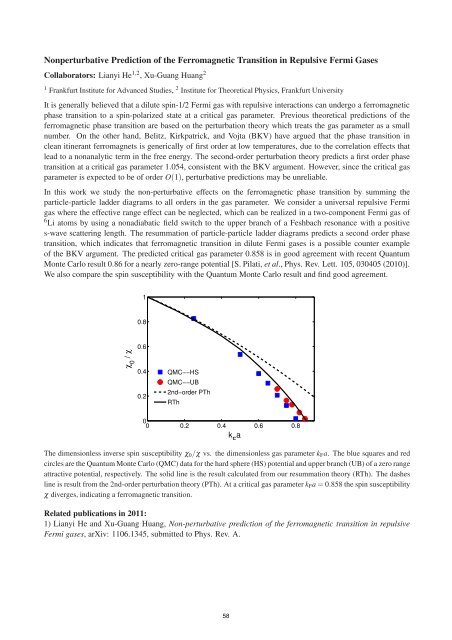FIAS Scientific Report 2011 - Frankfurt Institute for Advanced Studies ...
FIAS Scientific Report 2011 - Frankfurt Institute for Advanced Studies ...
FIAS Scientific Report 2011 - Frankfurt Institute for Advanced Studies ...
You also want an ePaper? Increase the reach of your titles
YUMPU automatically turns print PDFs into web optimized ePapers that Google loves.
Nonperturbative Prediction of the Ferromagnetic Transition in Repulsive Fermi Gases<br />
Collaborators: Lianyi He 1,2 , Xu-Guang Huang 2<br />
1 <strong>Frankfurt</strong> <strong>Institute</strong> <strong>for</strong> <strong>Advanced</strong> <strong>Studies</strong>, 2 <strong>Institute</strong> <strong>for</strong> Theoretical Physics, <strong>Frankfurt</strong> University<br />
It is generally believed that a dilute spin-1/2 Fermi gas with repulsive interactions can undergo a ferromagnetic<br />
phase transition to a spin-polarized state at a critical gas parameter. Previous theoretical predictions of the<br />
ferromagnetic phase transition are based on the perturbation theory which treats the gas parameter as a small<br />
number. On the other hand, Belitz, Kirkpatrick, and Vojta (BKV) have argued that the phase transition in<br />
clean itinerant ferromagnets is generically of first order at low temperatures, due to the correlation effects that<br />
lead to a nonanalytic term in the free energy. The second-order perturbation theory predicts a first order phase<br />
transition at a critical gas parameter 1.054, consistent with the BKV argument. However, since the critical gas<br />
parameter is expected to be of order O(1), perturbative predictions may be unreliable.<br />
In this work we study the non-perturbative effects on the ferromagnetic phase transition by summing the<br />
particle-particle ladder diagrams to all orders in the gas parameter. We consider a universal repulsive Fermi<br />
gas where the effective range effect can be neglected, which can be realized in a two-component Fermi gas of<br />
6 Li atoms by using a nonadiabatic field switch to the upper branch of a Feshbach resonance with a positive<br />
s-wave scattering length. The resummation of particle-particle ladder diagrams predicts a second order phase<br />
transition, which indicates that ferromagnetic transition in dilute Fermi gases is a possible counter example<br />
of the BKV argument. The predicted critical gas parameter 0.858 is in good agreement with recent Quantum<br />
Monte Carlo result 0.86 <strong>for</strong> a nearly zero-range potential [S. Pilati, et al., Phys. Rev. Lett. 105, 030405 (2010)].<br />
We also compare the spin susceptibility with the Quantum Monte Carlo result and find good agreement.<br />
χ 0 / χ<br />
1<br />
0.8<br />
0.6<br />
0.4<br />
0.2<br />
QMC−−HS<br />
QMC−−UB<br />
2nd−order PTh<br />
RTh<br />
0<br />
0 0.2 0.4 0.6 0.8<br />
The dimensionless inverse spin susceptibility χ0/χ vs. the dimensionless gas parameter kFa. The blue squares and red<br />
circles are the Quantum Monte Carlo (QMC) data <strong>for</strong> the hard sphere (HS) potential and upper branch (UB) of a zero range<br />
attractive potential, respectively. The solid line is the result calculated from our resummation theory (RTh). The dashes<br />
line is result from the 2nd-order perturbation theory (PTh). At a critical gas parameter kFa = 0.858 the spin susceptibility<br />
χ diverges, indicating a ferromagnetic transition.<br />
Related publications in <strong>2011</strong>:<br />
1) Lianyi He and Xu-Guang Huang, Non-perturbative prediction of the ferromagnetic transition in repulsive<br />
Fermi gases, arXiv: 1106.1345, submitted to Phys. Rev. A.<br />
58<br />
k F a
















